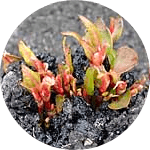Common Ragwort Removal & Control

The overview
Common Name: Common Ragwort
Latin name: Jacobaea vulgaris
In Detail
- Each plant can produce thousands of seeds.
- Seeds are dispersed by wind and require bare ground to germinate.
- Plants can spread quickly in areas of bare ground and where land is poorly managed or disturbed.
- Seeds can remain dormant in the soil for several years.
- Common ragwort provides an important food source for a large number of insects, bees, butterflies and moths.
Who we help
We have a long track record of managing some of the most complex sites in the country and have worked with the Environment Agency on several large flood alleviation projects, as well as providing advice to the majority of house builders and developers in the UK.
Click here to view who we help







Identification
- The plant is a biennial, the first years growth produces dense rosettes close to the ground.
- In the second year, the plant grows to 30 – 100cm in height, producing clusters of daisy like yellow flowers from June to November. Flower stems die back after producing seeds.
- Leaves are dark green in colours and strongly divided.
- If cut or mown, the plant acts as a perennial rather than biennial.
What’s the problem?
- Common ragwort is one of the five injurious plant species listed under the Weeds Act 1959.
- Contains toxic pyrrolizidine alkaloids.
- Can cause poisoning to livestock if present in hay.
Legislation *England
The Weeds Act 1959
- Under the Act, the Secretary of State may serve a notice on an occupier of any land on which the injurious weeds are growing, requiring the occupier to take action to prevent the weeds from spreading.
- The Act permits authorised officials to enter land to inspect whether an enforcement notice has been complied with.
- If an occupier has unreasonably failed to comply with the notice, they shall be guilty of an offence and liable to a fine.
- If the occupier of the land fails to take action, the Act allows for the weeds can be cleared and the costs recovered from the occupier/ owner, if necessary through the Courts.
The Ragwort Control Act 2003
- The Ragwort Control Act 2003 allowed for the production of the ‘Code of Practice’. This code of practice does not seek to eradicate ragwort but helps to prevent the spread of the plant onto land used for horses, livestock and forage production.
Responsibility to Control the Spread of Ragwort
The responsibility for the control of ragwort rests with the occupier of the land. It is expected that all landowners and occupiers will take responsibility to ensure the effective control of the spread of ragwort.
The code of Practice advises that the most effective way to prevent the spread of ragwort is to preclude its establishment through the strategic management rather than last minute control.
Action should be taken to prevent its spread when ragwort poses a high risk to land used for grazing or forage production. The Code of Practice outlines 3 categories; high, medium or low as guidelines for assessing the risk.
- High Risk – Ragwort is present and flowering/seeding within 50m of land used for grazing or forage production. Immediate action to control the ragwort must be taken.
- Medium Risk – Ragwort is present and flowering/seeding within 50m to 100m of the land used for grazing or for forage production. In this case, the occupier must put together an action plan and control policy.
- Low Risk – Ragwort is present and flowering/seeding from land used 100m from land used for grazing or forage production. Although no immediate action to control the ragwort needs to be taken, the distances above are only used as guidelines for assessing the risk. At JKSL, our surveyors are fully trained at assessing risk and factoring all the relevant circumstances such as topography, natural barriers, vegetation etc.
Control and removal of Common Ragwort
The control of ragwort will be dictated around the risk category and the current land use. The management of a grazed pasture will be treated with a different methodology to that of a roadside verge. In most cases a single application or control method will not be effective. Below are some of the control methods that can be used.
Cutting
- This can be used as last resort in order to prevent reseeding. It is essential that plants are cut before flowering begins.
- Cutting can stimulate growth and cause the plant to re-flower later in the season.
- Cutting at early flowering stage may reduce seed production, but is not generally a recommended method as it does not destroy the plant.
- Cut plants remain toxic.
Pulling/Digging
- Hand pulling or digging can be practical when tackling ragwort over a small area. Over larger areas machine pulling may be required.
- Hand pulling can provide a long-term control without the need of chemicals.
- It is essential that as much root system as possible is removed, as ragwort can regenerate from root fragments.
- Pulled plants must be disposed of accordingly.
Chemical treatment
- Herbicide must only be applied by fully NPTC trained operatives.
- Method of application will depend on factors such as size of area to be treated, the current use of the land, density of infestation etc..
- Herbicide treatment can be time efficient and an effective treatment method.
Other treatment options
- In some cases a spot burner can be used at rosette stage of the plants growth. However, there are risks involved in this method and consideration will need to be considered to the potential damage that may be done to surrounding vegetation and the risks of fire.
- Biological control aims to control the ragwort through using the plants natural enemies to weaken and suppress ragwort populations. Biological control is not always feasible on all sites and is not a standalone methodology.
Ragwort Disposal
Ragwort remains toxic when dried and can be become more palatable to horses and livestock. Ragwort is also able to go to seed even after it has been pulled or cut. Ragwort should therefore be disposed of in a careful manner and should only be transported in sealed bags or containers.
There are a few different methods of disposal, selection will vary depending on sites, quantity of material etc.
What to do?
There are many different approaches in tackling Ragwort. Whichever methodology is used it is essential that all works are in accordance to the Code of Practice. The key to any successful control technique is a good grass and soil management practice.
If you have concerns over ragwort on your land and are unsure of your legal responsibilities please contact our specialist surveyors. Treatment costs start from £380.00 + VAT.

Where we have worked
We operate nationwide with a Rapid Response Team on standby 7 days a week, to deal with the most urgent client enquiries.
We’re a dedicated team of professionals who share a great deal of experience. We invest heavily in the continual training of all our employees, ensuring you always have a highly qualified team working on your project with the latest industry accreditations.
Our process

1. Identify
Our first step is to identify if you have an invasive plant. For a quick ID, you can send us some photos. Alternatively, we can carry out a full site survey to confirm the extent of the infestation.

2. Solution
We will provide a range of treatment options individually tailored depending on your site requirements.

3. Quote
A detailed breakdown of costs for each phase of treatment will be provided, including on-going monitoring programmes with insurance backed guarantees.

4. Removal
Our experienced and professional in-house teams will carry out the treatment to the highest of standards to achieve full eradication. All works are carried out in accordance with the INNSA Code of Practice.

5. Treatment
A range of treatment solutions are available, from in-situ herbicide application to excavation and removal or burial. All carried out in-house by our experienced team.

